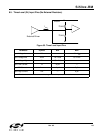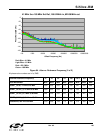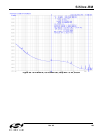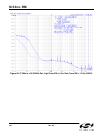
Si53xx-RM
Rev. 0.5 123
Reference vs. Output Frequency
Because of internal coupling, output frequencies that are an integer multiple (or close to an integer multiple) of the
XA/XB reference frequency (either internal or external) should be avoided. Figure 62 illustrates this by showing a
38.88 MHz reference being used to generate both a 622.08 MHz output (which is an integer multiple of 38.88 MHz)
and 696.399 MHz (which is not an integer multiple of 38.88 MHz). Notice the mid-band spurs on the 622.08 MHz
output, which contribute to the RMS phase noise for the SONET jitter masks. Their effect is more pronounced for
the broadband case. For more information on this effect, see "Appendix G—Near Integer Ratios" on page 162.
Figure 62. Reference vs. Output Frequency
The crystal frequency of 114.285 MHz was picked for its lack of integer relationship to most of the expected output
frequencies. If, for instance, an output frequency of 457.14 MHz (= 4 x 114.285 MHz) were desired, it would be
preferable not to use the 114.285 MHz crystal as the reference. For a more detailed study of this, see "Appendix
G—Near Integer Ratios" on page 162.
Table 62. Jitter Values for Figure 62
696.399 MHz Out 622.08 MHz Out
Jitter Bandwidth Yellow, fs RMS Blue, fs RMS
SONET_OC48, 12 kHz to 20 MHz 379 679
SONET_OC192_A, 20 kHz to 80 MHz 393 520
SONET_OC192_B, 4 MHz to 80 MHz 210 191
SONET_OC192_C, 50 kHz to 80 MHz 373 392
Broadband, 800 Hz to 80 MHz 484 1,196
155.52 MHz in, 622.08 MHz out, 696.399 MHz out
-160
-140
-120
-100
-80
-60
-40
-20
0
100 1000 10000 100000 1000000 10000000 100000000
Offset Frequency (Hz)
Phase Noise (dBc/Hz)
Yellow—696.399 MHz output
Blue—622.08 MHz output


















